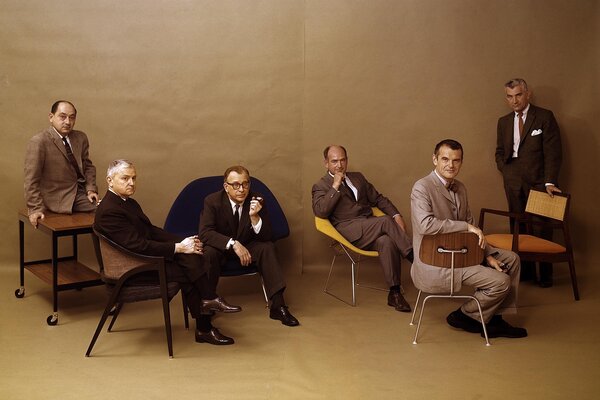We Read Midcentury Playboy for the Articles—on Modern Design
The legendary men’s lifestyle magazine endorsed radical designs of the time, and another type of voyeurism: the domestic kind.

The legendary men’s lifestyle magazine endorsed radical designs of the time, and another type of voyeurism: the domestic kind.
In the decades since its release, Playboy’s July 1961 issue has become somewhat of a collectible. But the reason driving that covetable status is probably different from what you think. It isn’t a particular Playmate, rather a multipage spread titled "Designs For Living," featuring rising modernist designers like Charles Eames, George Nelson, and Harry Bertoia—and, of course, their beloved creations: Eames’s Lounge Chair, Nelson’s Coconut Chair, and Bertoia’s Diamond Chair among them.
"Exuberance, finesse, and high imagination characterize U.S. furniture design today," begins the article by John Anderson, a longtime writer for the magazine. It’s a sharply written academic exploration of New American design ethos that bobs and weaves from Bauhaus traditions to the modern art movement. Pioneering designers like Hans Wegner, Eero Saarinen, Jens Risom, and Paul McCobb are all mentioned. This type of Playboy feature was not an anomaly; if you flipped through the magazine from the 1950s through the 1970s, you’d spot write-ups about architecture, furniture, and other decor.

Playboy’s July 1961 issue included a multipage spread featuring rising modernist designers George Nelson, Edward Wormley, Eero Saarinen, Harry Bertoia, Charles Eames, and Jens Risom (from left) with their groundbreaking creations.
© Marvin Koner
The magazine was early to profile architects like Ludwig Mies van der Rohe, Frank Lloyd Wright, and Frank Gehry. One 1968 issue showcased modern lighting, introducing American readers to Italian designers Giancarlo Mattioli and Achille Castiglioni. The recurring A Playboy Pad column celebrated sleek architecture and masculine interior design, helping establish the stylistic hallmarks of an aspirational bachelor pad for entire generations. Some of the homes were downright eccentric, often veering into fantasy, like artist Chip Lord’s Space-age Ant Farm compound in Texas, while others skewed more cosmopolitan, like a SoHo loft with multilevel flooring. The October 1956 issue included illustrations of the quintessential Playboy penthouse; in it, the bedroom is furnished with Saarinen’s groundbreaking Womb chair, a glass-and-wood coffee table designed by Isamu Noguchi, and a cowhide-covered Eames plywood LCW chair.
Looking back, Playboy was obsessed with all things "modern." (The magazine seemed to love that word.) The first-ever issue in December 1953 included a piece called "Desk Design for The Modern Executive." For at least a decade, the Modern Living column spotlighted the latest in home decor and furnishings. Occasionally, the magazine would take things one step further, offering informative guides on how men could improve the design of their spaces.
Not every design choice that Playboy promoted was a winner. There was plenty of good—the Noguchi tables and Eames chairs—and some less noble, even pervy: mirrors on the ceiling, rotating bed frames, and so on.
A 2013 research project by architectural historian Beatriz Colomina and the Princeton School of Architecture entitled "Playboy Architecture, 1953-1979" proposed that Playboy served "a crucial yet relatively unacknowledged role" in cultivating American design culture; the research found that Hefner’s title was ahead of other popular lifestyle magazines in promoting modern architecture and design to millions of readers. (In 2016, Colomina’s project became a museum exhibit that included design-centric articles and images from more than 30 Playboy issues.)
It’s not a stretch to say the magazine ushered in the archetypal high-taste bachelor pad. And not every design choice that Playboy promoted was a winner. There was plenty of good—the Noguchi tables and Eames chairs—and some less noble, even pervy: mirrors on the ceiling, rotating bed frames, and so on. Yet, there’s no question the attention Playboy gave to midcentury-modern architecture and design heavily shaped the aesthetic decisions of its target audience—heterosexual American men—during the ’60s and ’70s. (Today, the company is a shell of its former self, currently in the midst of yet another relaunch, but the title hit peak circulation and influence in 1975 when an average issue sold 5.6 million copies.)
Playboy was undoubtedly one of the first midcentury tastemakers to help weave modernism into the fabric of mainstream America. Some 70 years have passed since that first issue, and many things about the magazine have not aged well—the furniture isn’t one of them.
Top photo by 1965 Rosol Collection/Diamond Images via Getty Images.
Related Reading:
